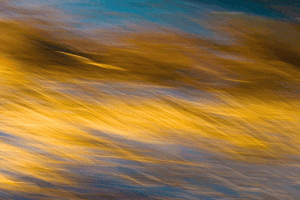I only recently discovered the potential of abstract photography. I knew abstract art existed, of course, but I’d never even considered it as something I wanted to spend my artistic time on. But about a year ago, I listened to several very successful fine art photographers talk about their approaches to abstract photography, complete with examples, and I was amazed at how beautifully nature can be depicted as abstractions.
Several months passed before I actually tried abstract photography. I was shooting at Chincoteague last Spring. While I normally attach my camera to a good tripod to ensure a sharp capture, on that day the wind was blowing so hard I could hardly stand up, let alone expect a tripod to firmly anchor my camera. So I took my camera in hand and thought I’d try this ‘abstract’ stuff. My subject was to be the salt marsh grasses violently yielding to the aforementioned wind.
I remembered one of the experts describe how moving the camera while clicking the shutter is a common technique for abstract art (there are several others). So that was what I’d try on my virgin attempt. The wind had the grasses of the salt marsh bent over about 45 degrees. I carefully practiced moving the camera parallel to the grasses, then actually took a couple frames.
Digital is great because you get immediate feedback by looking at the LCD screen on the back of the camera. After a very few tries, this is what I saw on the LCD, and I very much liked it.

The technique itself is straightforward and very rewarding if an abstraction is what you are after. Use a slow shutter speed so that there is distinct motion during the exposure. How slow will depend on how fast you intend to move the camera. Certainly, if your shutter speed is 1/100 sec, you need to be moving the camera pretty darn fast, and hold onto it very tightly. I recommend a much slower shutter speed- 1/2 to 1 sec even. Set that first, then meter the scene to see what aperture matches that speed. Remember that small apertures are okay, e.g. f/22 or f/32. Diffraction limitations seen at those apertures are not a concern with abstractions. Then experiment. Try different shutter speeds, different directions of movement (even circular), and various magnitudes of movement. Very small movements of the camera will give different results than large movements. By the way, this technique is even adaptable to camera phones, and Tony Sweet and others have written several articles about this.
Because of the fluid conditions used in abstract photography, the images created are exceptionally unique. In fact, I find it very difficult to reproduce a frame after I’ve captured it. I produced most of the linked abstractions below within an hour of one another and within 10 steps of each other. The landscape was a very popular and well-photographed waterfall (Elakala Falls) in West Virginia. This natural landmark has been captured photographically a million times. So after I took a few traditional pictures that I suspect will look like everyone else’s, I thought abstractly! I’m glad I did.
Abstract art has a definition, but I’ve found that it is only loosely applied. The strict definition goes something like: “..if you can tell what the subject is, it ain’t abstract.” Others consider even traditional black and white images to be “abstract” because B&W doesn’t represent the real scene factually (i.e., it’s missing color). Thus, it is ‘abstract.’ I don’t know where, or if, there is a line between representational and abstract art, and frankly I don’t really care. I’m sure someone will correct me if I mis-characterize my art as “abstract” one day when it’s not. I’m prepared to wait.
What are your experiences with abstract photography? I’m definitely a novice at it, but I’m very pleased with this approach to create unique images of well-photographed places. I don’t see abstract replacing my current style, but I’m not going to limit myself and my art for the sake of being traditional, either. I see abstractions complementing my traditional fine art photography. As long as I have fun with it and as long as the images I produce are pleasing to me and my audience, I’ll keep it in my art toolbox.
Let me hear your comments!
Jim
